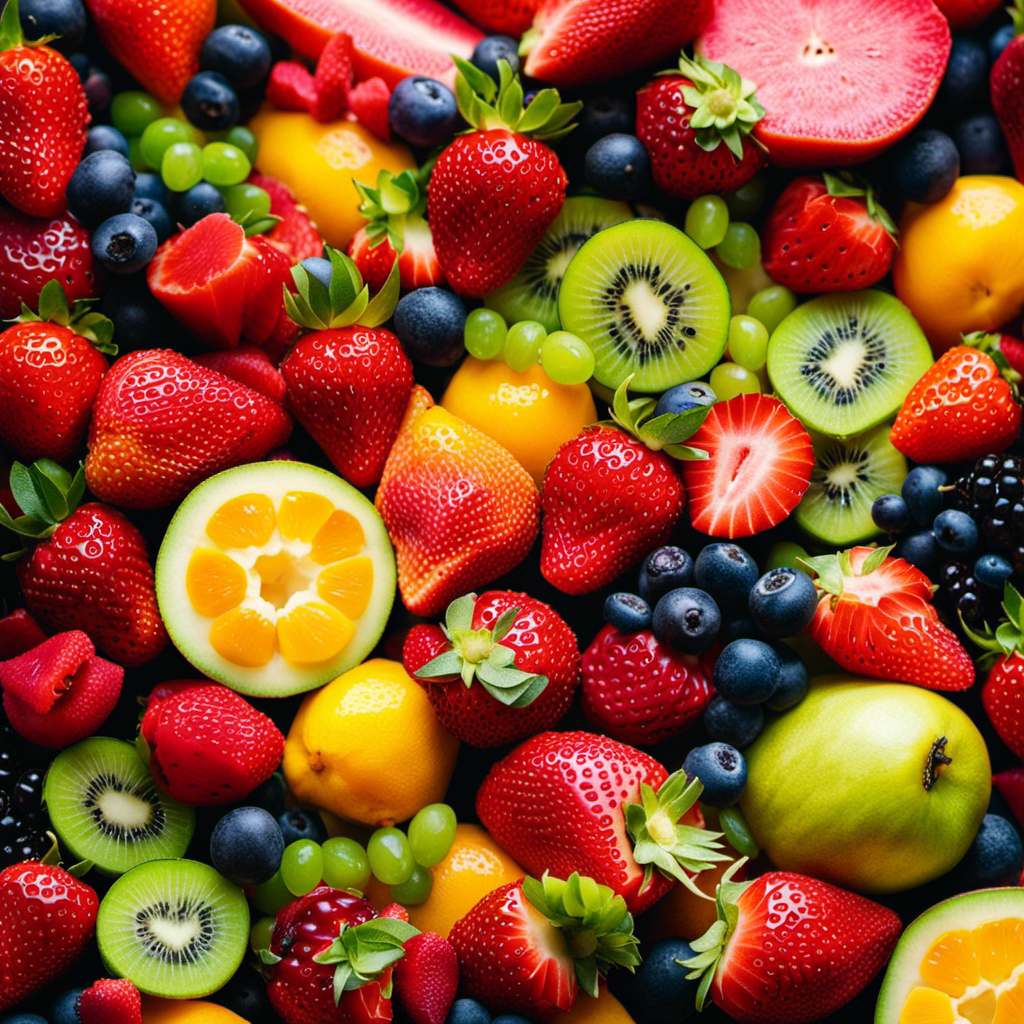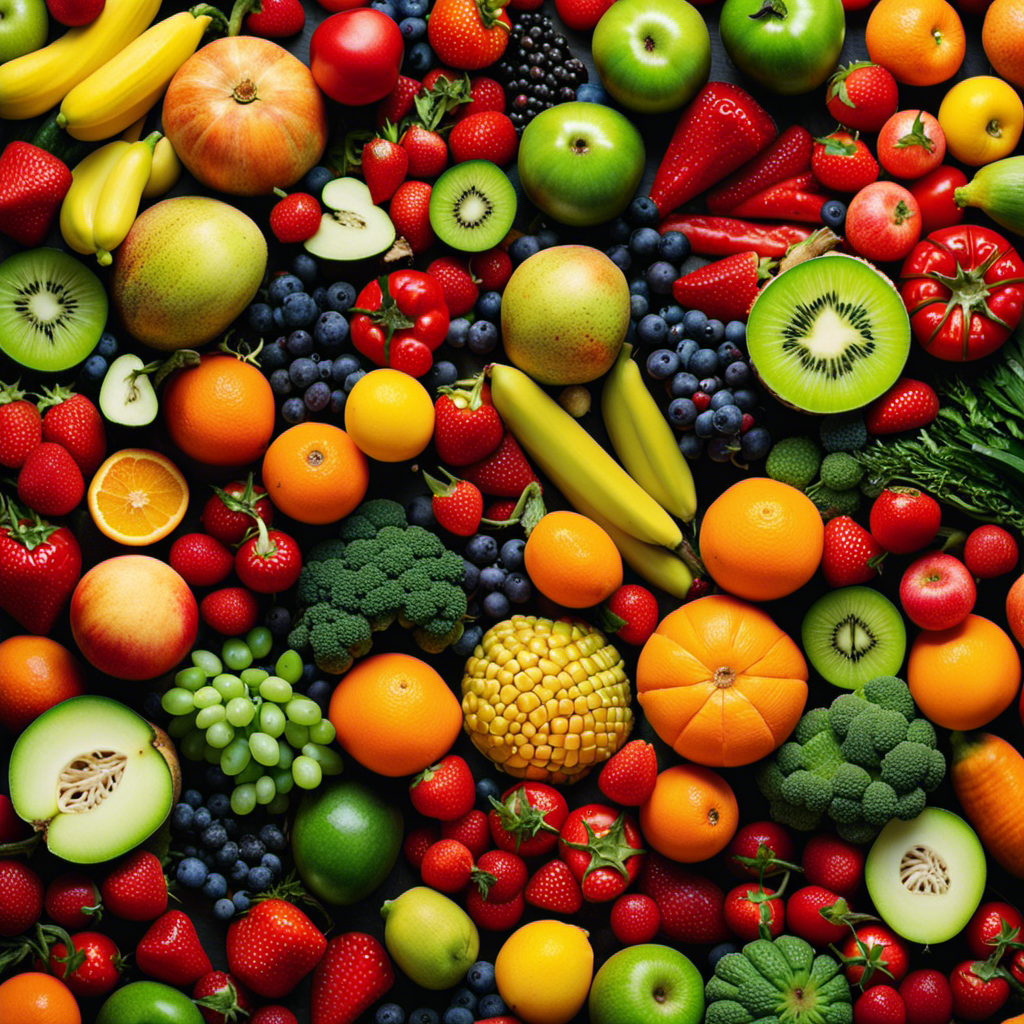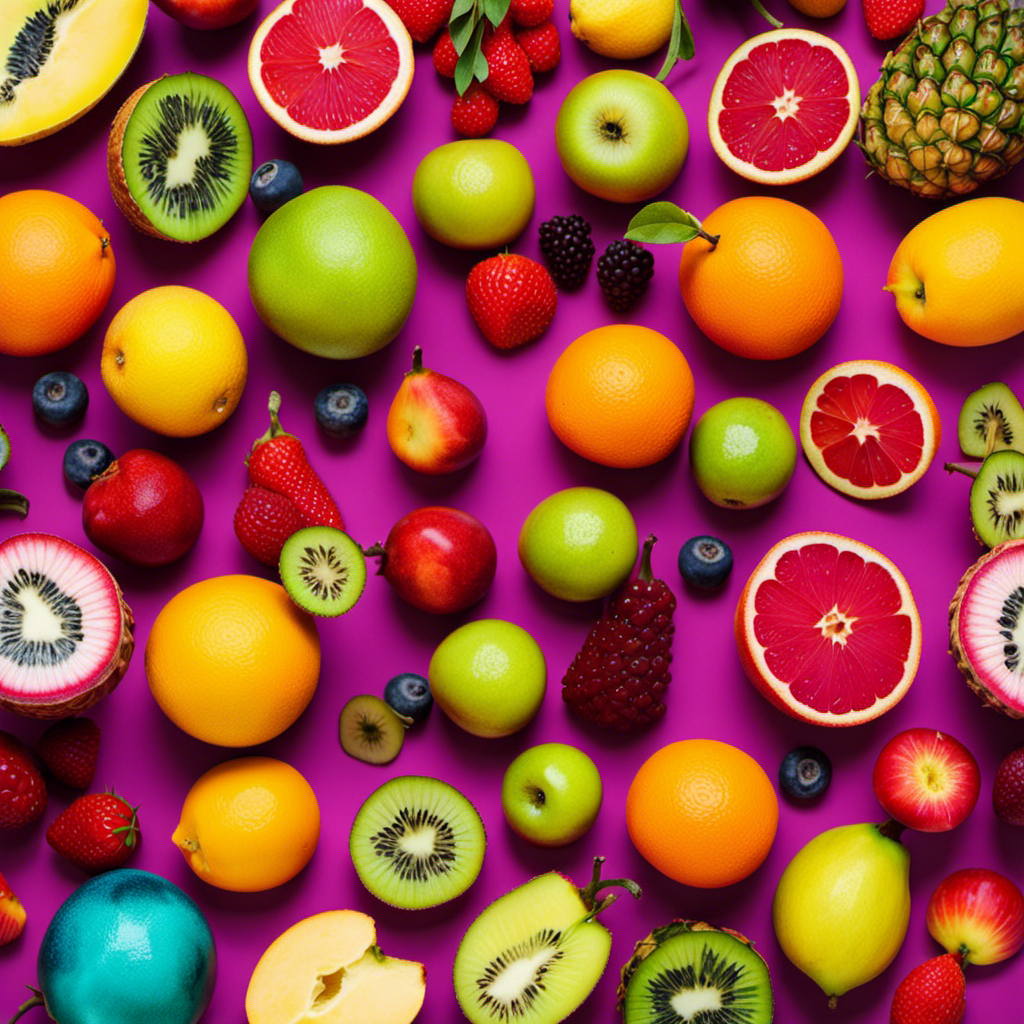Are you ready to discover the fascinating world of fruits?
Get ready to be amazed by the top 15 fun and nutritious fruit facts that will leave you craving for more!
From the surprising history of fruit consumption to the mind-blowing trivia from around the globe, this article will take you on a journey like no other.
So grab your favorite fruit and prepare to be enlightened about its incredible health benefits and much more.
Let’s dive into this colorful and delicious adventure together!
Key Takeaways
- Fruits provide essential vitamins, minerals, and antioxidants.
- Ancient civilizations recognized the nutritional and medicinal value of fruits.
- Changing lifestyles and globalization influence choices in fruit consumption.
- Exotic fruits offer endless possibilities for unique recipes and cultural exploration.
10 Amazing Health Benefits of Fruits
Did you know that fruits offer a wide range of amazing health benefits? Incorporating fruits into your diet can have a transformative effect on your overall well-being. These amazing fruit facts will surely inspire you to increase your fruit consumption and reap the incredible benefits they provide.
Fruits are not only delicious but also packed with essential vitamins, minerals, and antioxidants that help boost your immune system, improve digestion, and promote healthy skin. Additionally, their high fiber content aids in weight management by keeping you full for longer periods.
Moreover, regular fruit consumption has shown to reduce the risk of chronic diseases such as heart disease and certain types of cancer. So why not explore the vast array of fruits available and enjoy all the amazing health benefits they have to offer?
The Surprising History of Fruit Consumption
Imagine a world where the origins of fruit consumption date back to ancient civilizations. Our ancestors first discovered the sweet and succulent flavors that nature had to offer. They marveled at the vibrant colors and refreshing tastes of fruits, incorporating them into their diets as a source of sustenance and pleasure.
Now fast forward to modern times. Our habits have drastically changed, with processed foods and sugary snacks dominating our plates. It’s time to delve into the surprising history of fruit consumption and explore how we can rekindle our connection with these ancient treasures to improve our health and well-being.
Ancient Fruit Consumption Origins
Long before modern civilization, people around the world were enjoying a wide variety of fruits. The origins of fruit cultivation can be traced back thousands of years to ancient civilizations who recognized the nutritional and medicinal value of these natural treasures. They cultivated fruits in their gardens and orchards, creating a diverse array of flavors and textures.
To ensure year-round availability, they developed innovative preservation techniques such as drying, smoking, and fermenting. These methods allowed them to enjoy the taste and health benefits of fruits even during times when fresh produce was scarce.
Ancient cultures also discovered ways to extract juice from fruits for refreshing beverages or concentrated sweeteners. Through their ingenuity, they laid the foundation for our modern enjoyment and understanding of fruits.
- Cultivating a rich tapestry of fruity delights
- Preserving nature’s bounty for all seasons
- Unleashing the power of fruit juices
- Pioneering ancient techniques that still influence us today
Changing Fruit Consumption Habits
You may be surprised to learn that your fruit consumption habits have changed over time, influenced by factors such as availability, convenience, and cultural preferences. As our lifestyles evolve, so do our choices when it comes to nourishing ourselves with nature’s sweet bounty. Let’s take a look at the impact of changing lifestyles on fruit consumption through the lens of some fascinating trends:
| Fruit Consumption Trends | Impact on Changing Lifestyles |
|---|---|
| Organic fruits are gaining popularity due to their perceived health benefits and environmental sustainability. | People are becoming more conscious about their well-being and the impact of their choices on the planet. |
| Convenience has become key in today’s fast-paced world, leading to an increase in pre-cut or individually packaged fruits. | Busy schedules demand quick and easy options for nutritious snacks on-the-go. |
| Exotic fruits from around the globe are now readily available, allowing us to explore new flavors and broaden our culinary experiences. | Globalization has opened doors for diverse cultural influences that enhance our sense of adventure and curiosity. |
Exploring the Colorful World of Exotic Fruits
Exploring the colorful world of exotic fruits is a delightful way to discover new flavors. Each fruit has its own unique origins, as diverse as the vibrant hues they come in. From the tropical rainforests of Southeast Asia to the lush valleys of South America, these fruits carry with them stories and traditions that have been passed down through generations.
By immersing yourself in this world, you can uncover not only the delicious taste but also the rich cultural significance behind each fruit. And don’t forget about the endless possibilities for unique fruit recipes! Whether it’s a refreshing mango salsa or a tangy dragon fruit smoothie bowl, incorporating exotic fruits into your meals will transport you to faraway lands and create a sense of belonging to a global community of food lovers.
So go ahead and embark on this fruity adventure; who knows what hidden gems you’ll find!
The Science Behind the Perfect Ripeness of Fruits
Now that you’ve explored the vibrant world of exotic fruits, let’s dive into the fascinating science behind the perfect ripeness of these delicious treats. Have you ever wondered how a fruit knows exactly when to ripen? It’s all thanks to the incredible ripening process and ethylene gas.
When a fruit is harvested, it may not be fully ripe yet. However, as it matures, it releases ethylene gas, which acts as a signal for other fruits nearby. This gas triggers a series of biochemical reactions within the fruit, causing it to soften and develop its characteristic flavors and aromas.
To help you understand this process better, take a look at this emotional table:
| Ripening Process | Ethylene Gas | Emotional Impact |
|---|---|---|
| Maturation | Released | Excitement |
| Softening | Triggered | Anticipation |
| Flavor Development | Enhanced | Joy |
Isn’t it amazing how nature orchestrates this beautiful dance of ripening? So next time you bite into a perfectly ripe fruit, remember the magic happening behind the scenes.
Unveiling the Secrets of Fruit Varieties and Hybrids
Unveiling the secrets of fruit varieties and hybrids, you’ll be amazed to discover the incredible range of flavors and textures that can be achieved through careful crossbreeding. Fruit breeding has become an art form, with scientists and farmers working together to create new and exciting combinations.
Here are some mind-blowing facts about fruit hybrids:
- Strawberries + Raspberries = The deliciously sweet and tangy Loganberry.
- Oranges + Mandarins = The juicy and easy-to-peel Tangerine.
- Apples + Pears = The crisp and refreshing Pineapple Pear.
- Mangoes + Plums = The tropical-tasting Mangosteen Plum.
- Grapes + Cherries = The irresistibly juicy Grapeberry.
Imagine biting into a fruit that combines your favorite flavors in one bite! With fruit breeding, the possibilities are endless. So embrace the excitement of trying new hybrid fruits – it’s like joining a secret club where every bite is a taste sensation that belongs only to you.
Fun and Creative Ways to Incorporate Fruits Into Your Diet
By incorporating a variety of fruits into your daily meals, you can add a burst of vibrant flavors and essential nutrients to your diet. Not only are fruits delicious, but they also offer numerous health benefits. From improving digestion to boosting immunity, fruits are nature’s gift to our well-being. To make it even more exciting, let’s explore some creative fruit recipes and the benefits of fruit infused water.
TABLE:
| Creative Fruit Recipes | Benefits of Fruit Infused Water |
|---|---|
| 1. Fruit salad with a twist: Mix different fruits for a colorful and refreshing salad. | 1. Hydration: Fruit infused water helps you stay hydrated throughout the day. |
| 2. Smoothie bowls: Blend your favorite fruits with yogurt or milk for a nutritious breakfast option. | 2. Detoxification: The natural antioxidants in fruit infused water aid in detoxifying your body. |
| 3. Grilled fruit skewers: Thread chunks of pineapple, melon, and berries onto skewers and grill them for a caramelized treat. | 3. Weight management: Fruit infused water is low in calories and can help curb cravings for sugary drinks. |
| 4. Frozen fruit popsicles: Puree mixed berries or tropical fruits with coconut water and freeze them into refreshing popsicles. | 4.Improved digestion: The fiber content in fruit infused water promotes healthy digestion. |
Get ready to embark on an adventurous journey filled with fruity delights that will not only satisfy your taste buds but also nourish your body from within!
The Role of Fruits in Preventing Chronic Diseases
Did you know that incorporating a variety of fruits into your diet can play a crucial role in preventing chronic diseases?
Here are three fascinating facts about the link between fruit consumption and disease prevention:
- Boosts Heart Health: Fruits, such as berries and citrus fruits, are rich in antioxidants like vitamin C and flavonoids. These powerful compounds have been shown to reduce inflammation, lower blood pressure, and improve heart health.
- Fights Against Oxidative Stress: The impact of antioxidants in fruits goes beyond heart health. Antioxidants help combat oxidative stress caused by free radicals in the body, which can lead to various chronic diseases including cancer and diabetes.
- Enhances Immune System: Many fruits are packed with essential vitamins and minerals that support immune function. By consuming a range of colorful fruits like oranges, kiwis, and papayas, you provide your body with the necessary nutrients to strengthen its defense against infections.
Lesser-Known Facts About the Nutritional Value of Fruits
Did you know that there are surprising benefits of fruits that you might not be aware of?
From boosting your immune system to improving brain function, fruits have incredible hidden powers.
Explore the lesser-known facts about fruit’s nutritional value and uncover the hidden nutrients that can transform your health in ways you never imagined.
Get ready to be amazed by the extraordinary potential of these colorful and delicious gifts from nature.
Surprising Fruit Benefits
Eating fruits regularly can provide surprising benefits for your health. Not only do they taste delicious, but they also offer a plethora of advantages that you may not be aware of.
Did you know that certain fruits can help improve your mood and boost your energy levels? It’s true! Citrus fruits like oranges and grapefruits are packed with vitamin C, which has been shown to enhance serotonin production in the brain, leading to feelings of happiness and well-being.
Another surprising fruit effect is their ability to aid in digestion. Fruits such as pineapple contain natural enzymes that can help break down proteins and promote better digestion.
Additionally, some fruits have unusual uses beyond consumption. For example, rubbing banana peels on mosquito bites or poison ivy rashes can alleviate itching and inflammation.
So next time you’re feeling down or need a natural remedy, consider reaching for a juicy piece of fruit – it might just surprise you with its incredible benefits!
Hidden Fruit Nutrients
Certain fruits, like berries and kiwis, are packed with antioxidants that can help protect your body against harmful free radicals.
But did you know that there are hidden fruit benefits and unusual fruit properties that can do so much more?
Take dragon fruit, for example. Its vibrant pink color not only makes it visually appealing but also indicates the presence of lycopene, a powerful antioxidant known for its anti-inflammatory properties.
Or consider the humble avocado. Beyond being a delicious addition to your meals, avocados contain monounsaturated fats that can help lower bad cholesterol levels and improve heart health.
And let’s not forget about pomegranates – their juicy seeds are rich in polyphenols, which have been shown to have anti-aging effects and may even help prevent certain types of cancer.
So next time you’re choosing your fruits, remember the hidden treasures they hold – nourishing your body in ways you might never have imagined!
Fruit Facts: Debunking Common Myths and Misconceptions
Contrary to popular belief, fruits do not necessarily cause weight gain when consumed as part of a balanced diet. In fact, they can actually aid in weight loss due to their high fiber content and low calorie density. It’s time to debunk the misconceptions surrounding fruit consumption and embrace the incredible health benefits they offer.
Fruits are packed with essential vitamins and minerals that support overall well-being. They are rich in antioxidants, which help protect against chronic diseases. The natural sugars found in fruits are accompanied by fiber, slowing down the absorption process and preventing blood sugar spikes. Fruits promote good digestion and gut health through their high water and fiber content. Regular fruit consumption has been linked to a reduced risk of heart disease, stroke, and certain types of cancer.
Embrace the power of fruits in your diet for optimal health and vitality. Join the fruit revolution today!
Mind-Blowing Trivia About Fruits From Around the World
Ready to unlock a world of vibrant flavors and incredible health benefits?
Get ready to dive into the fascinating realm of exotic fruit varieties explained, where you’ll discover the hidden treasures Mother Nature has in store for you.
From the mouthwatering sweetness of dragon fruit to the tart tanginess of durian, these unique fruits not only tantalize your taste buds but also pack a punch when it comes to nourishing your body with essential vitamins and minerals.
So get ready to embark on a journey that will leave you craving more than just your average apple or banana.
Exotic Fruit Varieties Explained
Did you know that there are many exotic fruit varieties that are both nutritious and delicious? Exotic fruit cultivation has been gaining popularity worldwide, as people seek out unique flavors to tantalize their taste buds.
These fruits not only offer a tropical escape but also provide an array of health benefits. From the vibrant dragon fruit with its antioxidant properties to the tangy passion fruit packed with vitamins and minerals, each exotic fruit brings something special to the table.
Imagine biting into a juicy lychee or savoring the sweet-tart taste of a rambutan; these fruits have the power to transport you to far-off lands where adventurous flavors await.
So why settle for ordinary when you can indulge in the extraordinary world of exotic fruits and experience a sense of belonging like never before?
Health Benefits of Fruits
Imagine how much better you’ll feel when you start incorporating a variety of fruits into your diet on a regular basis. Not only will fruit consumption aid in weight loss, but it can also help you achieve glowing skin.
Here are four reasons why fruits are essential for your well-being:
- Weight Loss: Fruits are low in calories and high in fiber, making them an ideal snack for those trying to shed extra pounds. They provide natural sweetness without the guilt.
- Glowing Skin: Certain fruits like berries and citrus fruits contain antioxidants that promote collagen production, leading to healthier and more radiant skin.
- Hydration: Many fruits have high water content, such as watermelon and grapes, which helps keep your body hydrated throughout the day.
- Nutrient Boost: Fruits are packed with vitamins, minerals, and antioxidants that support overall health and boost your immune system.
Incorporating these vibrant wonders into your daily routine will not only improve your physical well-being but also leave you feeling connected to nature’s abundant gifts.
Frequently Asked Questions
What Are Some Unique and Uncommon Fruits That Are Not Mentioned in the Article?
Looking for exotic and tasty fruits? Explore unusual fruits for culinary exploration. Discover unique and uncommon options that are not mentioned in the article. Expand your palate and satisfy your adventurous spirit!
How Can Fruits Be Used in Skincare and Beauty Routines?
Using fruits in your skincare routine has numerous benefits. Fruit-infused skincare products provide essential nutrients for healthy, glowing skin. DIY fruit face masks are a fun and effective way to achieve radiant complexion and belong to a community of self-care enthusiasts.
Are There Any Specific Fruits That Can Help With Weight Loss?
Looking to shed some pounds? Incorporating certain fruits into your diet can aid in weight loss. Additionally, these same fruits can also give you a glowing complexion, making you feel confident and beautiful.
Can You Provide Tips on How to Properly Store Fruits to Maximize Their Shelf Life?
To prevent fruit from spoiling quickly, here are some fruit storage hacks. Keep them in the refrigerator, separate them based on ripeness, and store delicate fruits like berries in a breathable container. Enjoy fresh fruits longer!
Are There Any Fruits That Are Considered Superfoods?
Yes, there are fruits that are considered superfoods. Incorporating superfoods like berries, avocados, and pomegranates into your diet can provide you with a wealth of nutrients and health benefits.
Conclusion
Congratulations! You’ve unlocked a treasure trove of knowledge by exploring the fascinating world of fruits. From their incredible health benefits to uncovering their rich history and global trivia, you now have a new appreciation for these colorful wonders of nature.
As you indulge in the deliciousness of fruits, remember that they are not only nutritious but also play a vital role in preventing chronic diseases. So go forth and enjoy the vibrant flavors while reaping the countless benefits that fruits have to offer.
Let the power of fruits nourish your body and inspire your mind to embrace a healthier lifestyle.





